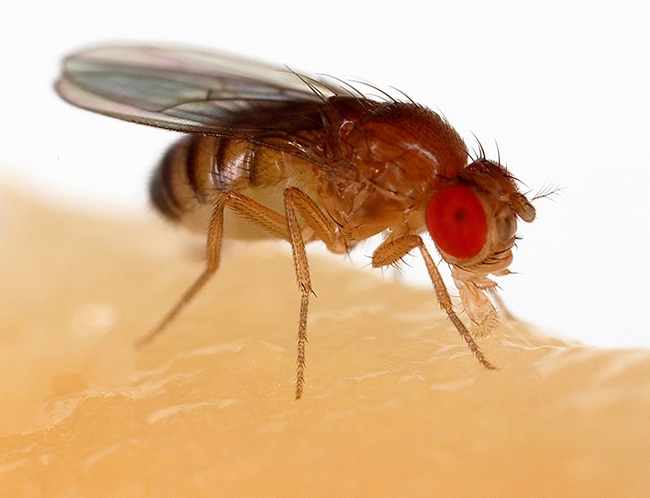- Author: Kathy Keatley Garvey

The paper, appearing online on the website of the Proceedings of the National Academy of Sciences (PNAS), solves a puzzle that scientists have tried to piece together for a long time.
The Chiu lab did it with the widely used model organism, Drosophila melanogaster, also known as the vinegar fly.
“This paper advances our understanding of how animals ‘sense' seasonal changes in day length and temperature to modulate their physiology and behavior in order to survive through seasonal variations in their environment,” Chiu said. “Specifically, we identified the protein EYA to be a key driver of seasonal changes in biology. By manipulating the level of EYA protein using transgenic technologies in specific neurons of the vinegar fly Drosophila melanogaster, we were able to disrupt the fly's ability to sense seasonal changes.”
“We were able to trick them into thinking that it is winter when it is actually summer time and vice versa,” Chiu said. “Interestingly, this protein is very conserved in other animals, including in birds and mammals, suggesting that the mechanism we are studying could be widely used in the animal kingdom.”
The paper, “EYES ABSENT and TIMELESS Integrate Photoperiodic and Temperature Cues to Regulate Seasonal Physiology in Drosophila,” is the work of the first author and postdoctoral fellow Antoine Abrieux, graduate students Yao Cao and Kyle Lewald, undergraduate researcher Hoang Nhu Nguyen, in collaboration with members of Dr. Yong Zhang's lab at the University of Nevada Reno. Associate Professor Joanna Chiu is the corresponding and senior author.

In their abstract, the seven-member team wrote: “Organisms possess photoperiodic timing mechanisms to detect variations in day length and temperature as the seasons progress. The nature of the molecular mechanisms interpreting and signaling these environmental changes to elicit downstream neuroendocrine and physiological responses are just starting to emerge. Here, we demonstrate that, in Drosophila melanogaster, EYES ABSENT (EYA) acts as a seasonal sensor by interpreting photoperiodic and temperature changes to trigger appropriate physiological responses. We observed that tissue-specific genetic manipulation of eya expression is sufficient to disrupt the ability of flies to sense seasonal cues, thereby altering the extent of female reproductive dormancy. Specifically, we observed that EYA proteins, which peak at night in short photoperiod and accumulate at higher levels in the cold, promote reproductive dormancy in female D. melanogaster.”
“Furthermore, we provide evidence indicating that the role of EYA in photoperiodism and temperature sensing is aided by the stabilizing action of the light-sensitive circadian clock protein TIMELESS (TIM). We postulate that increased stability and level of TIM at night under short photoperiod together with the production of cold-induced and light-insensitive TIM isoforms facilitate EYA accumulation in winter conditions. This is supported by our observations that tim null mutants exhibit reduced incidence of reproductive dormancy in simulated winter conditions, while flies overexpressing tim show an increased incidence of reproductive dormancy even in long photoperiod.”
Research in the Chiu lab focuses on the regulation of biological rhythms and their control over organismal physiology. Her expertise involves molecular genetics of animal behavior, circadian and seasonal biology, and posttranslational regulation of proteins.
By using Drosophila melanogaster as a model to study the mechanisms that regulate circadian clocks, Chiu has discovered new insights into the function of key proteins that control animal circadian clocks. She earlier identified new mechanisms that slow down or speed up the internal clock of vinegar flies and mechanisms that allow the internal clock to interpret food as timing cues--research that could help lead the way to alleviate human circadian and metabolic disorders.
“Besides being indispensable for the control of daily activities in animals, such as the sleep-wake cycle, locomotor activity, hormone circulation and food intake, defects in circadian rhythms and clock genes have also been implicated in a wide range of human disorders, including chronic sleep orders, various forms of depression, metabolic syndromes, as well as susceptibility to cancer and drug and alcohol addiction,” Chiu says.
D. melanogaster is widely used for biological research due to its rapid life cycle, simple genetics (only four pairs of chromosomes), and its large number of offspring per generation, according to Wikipedia. As of 2017, six Nobel prizes had been awarded for research using Drosophila.
The fly, a member of the family Drosophilidae, is a nuisance pest found worldwide in restaurants and other places where food is served.
First author and postdoctoral fellow Antoine Abrieux, an international scholar from France, holds a doctorate from Angers University, France. He joined the Chiu lab in spring 2016 to explore interactions between the clock and endocrine system underlying seasonal adaptation in Drosophila suzukii. He discussed his work at a UC Davis Department of Entomology and Nematology seminar in February 2019 about the molecular mechanisms involved in seasonal adaptation in insects.



